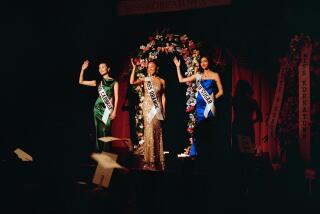A filmmaker chronicles the Americanization of Little Saigon
Orange County has many faces. Some are beautiful; some less so. Some are revealed; some stay hidden.
Le-Van Kiet knows about hidden faces. He came of age in Little Saigon when urban myth defined much of his surroundings and masked the life he saw unfolding around him. The popular impression beyond the fortified insulation of Little Saigon was that the community was a bastion of hard-working parents and motivated, successful children -- linked by rock-solid family structures and codes of behavior that often were the envy of American culture.
Le, whose family fled Vietnam and came to Orange County in 1982 when he was 4, saw all that. But he also saw much more.
And therein lies the poignancy of “Dust of Life,” the low-budget film he’s written and directed and that premieres at 7 p.m. Sunday in the Humanities Instructional Building at UC Irvine to conclude the Vietnamese International Film Festival.
Now 29 and a graduate of UCLA’s film school, Le has put his memories of the early 1990s -- when he was a teenager -- into the movie, shooting it entirely in the Orange County where he still lives.
In the vernacular, it’s a gritty look at Vietnamese gang life and the crimes and violence it produced, set against family relationships that provided balm but, unwittingly, also sowed some of the seeds of the teenagers’ alienation.
It is difficult to generalize about large groups of people, and Le is wary of doing so. But he knows this turf well, he says, and thinks the time is right to tell a story many people don’t know.
We met last week in a coffee shop across the street from Mile Square Park in Fountain Valley, where he shot some scenes. As tough and touching as his film is, that’s how upbeat and serene Le appears to be, even while talking about the difficult teen years of his generation.
“In every way,” he says, “teens back then were displaced. When they went to school, they felt displaced. When they were home, they felt displaced because they had to act in a very traditional Vietnamese way, very obedient and submissive. In American culture, they don’t teach that.”
Strong family bonds existed, he says, but sometimes those bonds became oppressive. Also, parents working multiple jobs while building a life in a new country meant they didn’t have as much time for their children as they wanted.
The result of all those conflicting currents, he says, was a more disaffected Vietnamese teen population than was realized by outsiders. Even in a simpler setting, of course, teen angst exists. But the complex of factors hitting young Vietnamese, he says, also spawned alienation and confusion that led not only to crime, but runaways and out-of-wedlock pregnancies, one of the most serious stigmas in Vietnamese society.
The spate of gang-driven home invasions that made news then were but a fraction of the number that actually occurred, Le says. Those crimes flourished, he says, because Vietnamese people still kept money at home instead of in banks and, once robbed, didn’t trust police enough to report the crimes.
I suggest the scope of social problems doesn’t square with traditional views of Little Saigon. “What we were really good at was hiding it,” he says. “I’m not saying we were completely bad and horrible. What I’m trying to say is that our assimilation was very normal. It wasn’t anything exceptional. Assimilation is very difficult. Given that definition, our assimilation was normal. Normally difficult.”
What isn’t a myth, he says, was how tough the older generation’s backbones were in restarting their lives in a strange country. “The strong point was our parents,” Le says. “And they didn’t crack. They didn’t snap.”
Wondering aloud about his own generation in comparison, he says, “I’m not sure we would have made this community as strong as it is.”
I ask about the lament, often heard then, that younger Vietnamese Americans didn’t seem to care about the old country. True, he says, to an extent.
“In my generation, we didn’t really have time to have such pride in our culture and history, because we were in a foreign country. Basically, we were forced to assimilate to this environment.”
Was there a thirst for a Vietnamese cultural heritage among the young? “During that time, no,” Le says. “Now, I see it more.”
“Dust of Life” took up about four years of Le’s life. These days, he’s helping his parents at their deli in Garden Grove. But inside beats the heart of a filmmaker. “You can go crazy talking about the obstacles ahead, but I came to realize through this film that the thing is to do something that is most honest and true to your heart.”
So why tell the story now? Why make a movie that shows a darker side of Vietnamese American life than they might want the world to see?
To my ears, Le’s answer was reassuring and may explain why I saw none of the brooding artist in him.
“I’m so excited about the future of Vietnamese Americans,” he says. “That’s why I was able to make this film. I would not have been able to make it 10 years ago. It would have been an impossibility, because the community wouldn’t have accepted it. But I think we are confident in ourselves now and we know ourselves so well that we can literally talk about our faults and our hardships.”
Dana Parsons’ column appears Tuesdays, Thursdays and Saturdays. He can be reached at (714) 966-7821 or at
[email protected]. An archive of his recent columns: www.latimes.com/parsons
More to Read
Only good movies
Get the Indie Focus newsletter, Mark Olsen's weekly guide to the world of cinema.
You may occasionally receive promotional content from the Los Angeles Times.










